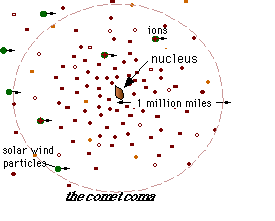This is an illustration of the orbits of the Jupiter Family of Comets.
Click on image for full size
The Jupiter family of comets
Astronomers have noticed a group of comets which they call the Jupiter Family of Comets.
This family of comets is to be found circling between Jupiter and the sun, as shown in this picture. The comets take 3-10 years to finish their orbits.
You might also be interested in:

Mathematical theory suggests that comet Shoemaker-Levy 9 was likely a short-period comet which was captured into orbit around Jupiter in 1929. This orbit ended with a collision of the comet with Jupiter
...more
Comet Hale-Bopp was one of the brightest comets of all time. Astronomers witnessed the comet spew out intermittent bursts of dust. The surface seemed to be an incredibly dynamic place, with 'vents' being
...more
Six spacecraft flew to Halley's comet in 1986. There were two spacecraft launched from Japan, named Suisei and Sakigake, and two from the Soviet Union, named Vega 1 & 2. One spacecraft, ICE, was from the
...more
Astronomers have noticed a group of comets which they call the Jupiter Family of Comets. This family of comets is to be found circling between Jupiter and the sun, as shown in this picture. The comets
...more
Scientists have learned a great deal from the crash of comet Shoemaker-Levy 9. Scientists traced the orbit of the comet backwards in time to guess its origin. The crash of a comet like Shoemaker-Levy 9
...more
As the ices of the comet nucleus evaporate, they expand into a large cloud around the middle part of the comet. This cloud, called the coma, is the atmosphere of the comet. It can extend for millions of
...more
When evaporation begins, the gas is propelled from the nucleus at supersonic speed (depicted by arrows in the figure). Because of the low gravity in space, this means that the molecules from the nucleus
...more














